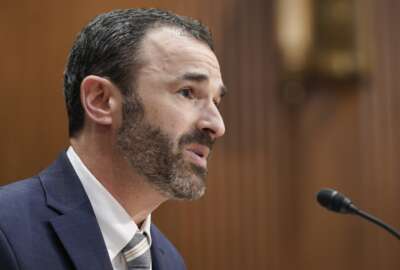9 ways to make government more efficient and effective
A new report by the Partnership of Public Service and Booz Allen Hamilton calls for a multiagency enterprise approach to the way the federal government handles...
One of the challenges the federal government faces in times of crisis, such as Hurricane Sandy, is coordinating the efforts of multiple agencies, some with shared or overlapping responsibilities, to respond to the problem in the most efficient, appropriate and economic manner.
One answer is for the government to take a multiagency enterprise approach to the way it handles, not just natural disasters, but major public policy goals like reducing joblessness, improving education or securing cyberspace.
The Partnership for Public Service and Booz Allen Hamilton released a report today, entitled “Building the Enterprise,” which calls for just such an approach in how the government tackles big initiatives with multiple agencies.
“By taking a multiagency enterprise approach to those challenges, we can build on the progress of the past two decades, improve the overall performance of the federal government and, in so doing, restore the American public’s trust and coinfidence in it,” Max Stier, PPS president and CEO, and Lloyd W. Howell Jr., Booz Allen Hamilton’s executive vice president, wrote in their introduction to the report.
The report, which started one-year ago, builds on the groundwork laid by the Government Performance and Results act of 1993 (GPRA) and the Government Performance and Results Modernization Act of 2010 (GPRAMA) in improving the way agencies solve problems together.
In GPRAMA, the Obama administration set 14 cross-agency priority goals that agencies were required to work together to meet in areas like energy efficiency, job training and doubling U.S. exports.
Working with 50 current and former civil servants, PPS and Booz Allen identified the following nine enterprise strategies to help make government more efficient and effective.
“Strategy 1 – Develop an enterprise performance plan with senior-level commitment to drive cross-agency goals and mission.”
The president and his Cabinet should identify policy priority goals and the agencies responsible for meeting them.
“Each enterprise goal should have a balanced scorecard of quantitative and qualitative performance objectives that commit the agencies involved to tangible individual and enterprise outputs and outcomes,” the report said.
The President’s Management Council (PMC) would also be tasked with implementing the strategic performance plan.
“Strategy 2 – Build portfolios of programs aligned against the enterprise plan’s goals”
The PMC will put together portfolios of federal programs that match with a particular policy priority.
“The portfolio approach will illuminate the strengths and weaknesses of existing programs and identify duplication as well as gaps,” the report said. “Portfolios of programs, not individual programs, will become the organizational approach to collectively achieve enterprise results.”
“Strategy 3 – Designate and empower enterprise goal leaders.”
Under GPRAMA, the president can name goal leaders to head up cross-agency policy priorities, charging them with the responsibility of setting up governance councils and tracking progress.
“Strategy 4 – Develop career enterprise executives to lead cross-cutting missions and functions.”
In order to develop senior executives with career enterprise experience, the report encourages the president to not limit enterprise goal leader appointments to the Cabinet or sub-Cabinet level. It also calls for the formation of an Enterprise Executives Resource Board to help foster senior leaders.
“Strategy 5 – Establish an independent office of evaluation to assess enterprise performance.”
The report calls for an Office of Evaluation to be established within the Office of Management and Budget or the Executive Office of the President to conduct program assessments to measure the progress being made.
“Strategy 6 – Manage information technology as a true enterprise resource.”
While the report applauds the Obama administration’s cross-agency shared services initiative, it says more needs to be done.
“The focus on enhancing IT capability should be expanded into a portfolio approach to all IT resources across the federal enterprise, not just with agencies,” the report said.
In addition, the federal chief information officer and the CIO Council should develop and lead the enterprise information technology strategy as part of Strategy 1.
“Strategy 7 – Take shared services to scale.”
The time is ripe to reap the benefits of shared services to increase efficiency and reduce costs.
“The original promise of shared services providers has not been met,” the report said. “The vision was that they would assume even more of the government’s common administrative workload, including labor-intensive functions such as the interaction between manager and a personnel specialist before a promotion decision is made and processed. Now it is time to realize that promise.
“Strategy 8 – Adopt an enterprise approach to the acquisition of goods and services.”
Both the Bush and Obama administrations have made progress in pursuing a more strategic path when it comes to acquisition at the department level. The report would like to see this progress extended across agencies.
“The government has not taken full advantage of its collective purchasing power to get the best deal for the taxpayer,” the report said.
“Strategy 9 – Build an enterprise civil service system.
The civil service system should be retooled so that it better meets the demands presented by a modern, multiagency enterprise approach to government.
“Such a civil service system would improve the ability of the enterprise to recruit and retain our nation’s best and brightest talent,” the report said. “Nonetheless, much would depend on the substance of the human capital policies. And if there is one lesson we have learned over the decades since the last time the civil service system was modernized, it is the importance of strategtic human capital planning.”
Copyright © 2025 Federal News Network. All rights reserved. This website is not intended for users located within the European Economic Area.
Michael O’Connell is senior digital editor of Federal News Network optimizing content for the best user experience. Follow @moconnellWFED
Follow @moconnellWFED






